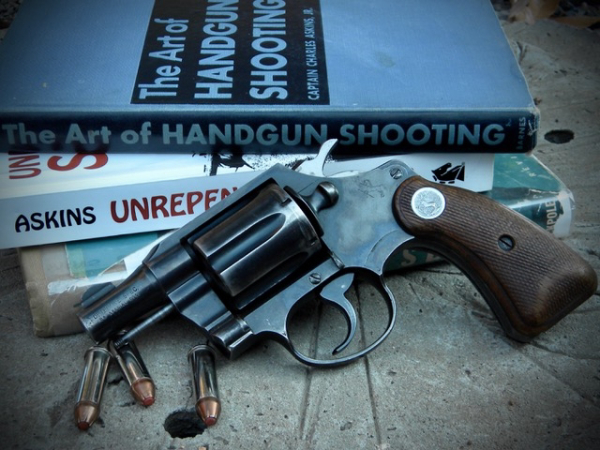
Today we’re studying one of the “Old Testament” prophets of hand gunning – Charles Askins, Jr. Askins was a lawman, serving on the southern border during the 1920-30’s. He was involved in a lot of gunfights. He was in WWII, with a lot of gun-play there. Askins worked with the government. He customized shotguns for defense, adding extended magazines, and worked with B.E. Myers to design a better fighting holster. He was an avid writer. Above all, Askins was a gunfighter.
My favorite works of his are Unrepentent Sinner and The Art Of Handgun Shooting.
Sinner is an autobiography, well worth reading. The Art covers in handgun shooting in detail, as it was known back in the 1940’s. “This book,” Askins states in the forward, “has been written for the two classes of pistol men: the beginner-shooters and the experts.”
Chapters cover the stance, gripping the handgun and various topics including pistol selection and basic and advanced training and drills. Although Askins discusses the sights throughout the book, there’s no “chapter” specifically devoted to their use. The most detail he gets into – that I recall – is when discussing the trigger. “…The sights are held in alignment, the front sight is moved into the bull’s-eye and while the front post is covering the black, pressure is applied to the trigger.” (Page 40) It’s not until Cooper’s contributions that we find “front sight focus.”
Trigger manipulation is Askins’ theme throughout the book. Chapter 7 is “How to Manage the Trigger.” Chapter 29 is devoted to double-action revolver work. (Remember, at this time most shooting was done in single action; cock the hammer and press off the shot.). For the police officer, which also includes self-defense work, Askins recommends “… double-action practice is very probably all that he should ever do,” but only after “deliberate and painstaking slow-fire practice.” (Page 200) I can’t remember a chapter where he doesn’t mention trigger control.
Askins strongly recommends positioning the trigger in the center of the finger’s pad – where you can “feel” what the trigger is doing - with that part of the finger perpendicular to the trigger, helping to ensure it is pressed straight to the rear. This is what I teach semi-auto shooters, but for some reason most revolver shooters today, and a lot of semi-shooters have finger jammed into the last joint of the finger.
Another theme of Askins’ is dry-fire practice, and lots of it. “Dry practice, religiously continued over a long period of time,” Askins tells us – before ever firing a live shot - “will do more to develop perfect trigger release than anything else.” (Pg. 48.) This practice develops a “feel,” so eventually one is “… so intimately familiar as to make the weapon almost a part of the man.” (Pg. 78.)
When it does come time to put hits on the threat Askins “…made a practice of holding at a spot approximately the height of an adversary’s belt buckle.” His thought “… was that the shots might then play a good many inches high or low and still be effective.” Pelvis shots are as great today as they were then.
Some aspects of defensive hand gunning have changed radically from Askins’ time. We know now to use a fighting stance as opposed to the old practice of blading the body. Firing with both hands is much more efficient than using only one. Other areas, such as trigger control will always be, as Askins said, “… everything – fully ninety per cent of the game.” (Pg.58.)
Tiger McKee is director of Shootrite Firearms Academy, which is celebrating its twenty-fifth anniversary. He is the author of The Book of Two Guns, AR-15 Skills and Drills, has a regular column in American Handgunner and makes some cool knives and custom revolvers. Visit Shootrite’s Facebook page for other details.